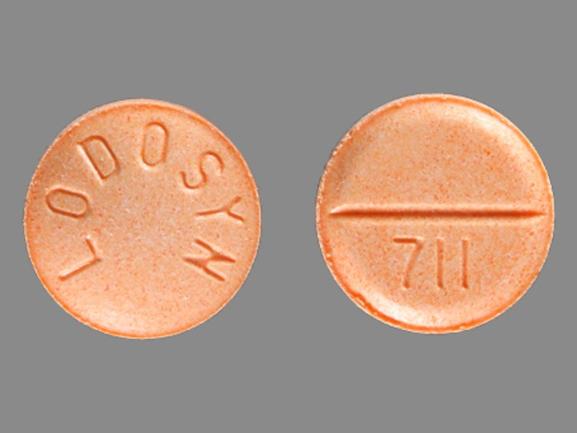Lodosyn Dosage
Generic name: carbidopa 25mg
Dosage form: tablet
Drug class: Dopaminergic antiparkinsonism agents
Medically reviewed by Drugs.com. Last updated on Jun 23, 2025.
Whether given with carbidopa-levodopa or with levodopa, the optimal daily dosage of LODOSYN must be determined by careful titration. Most patients respond to a 1:10 proportion of carbidopa and levodopa, provided the daily dosage of carbidopa is 70 mg or more a day. The maximum daily dosage of carbidopa should not exceed 200 mg, since clinical experience with larger dosages is limited. If the patient is taking carbidopa-levodopa, the amount of carbidopa in carbidopa-levodopa should be considered when calculating the total amount of LODOSYN to be administered each day.
Patients Receiving Carbidopa-Levodopa Who Require Additional Carbidopa
Some patients taking carbidopa-levodopa may not have adequate reduction in nausea and vomiting when the dosage of carbidopa is less than 70 mg a day, and the dosage of levodopa is less than 700 mg a day. When these patients are taking carbidopa-levodopa, 25 mg of LODOSYN may be given with the first dose of carbidopa-levodopa each day. Additional doses of 12.5 mg or 25 mg may be given during the day with each dose of carbidopa-levodopa. LODOSYN may be given with any dose of carbidopa-levodopa as required for optimum therapeutic response. The maximum daily dosage of carbidopa, given as LODOSYN and as carbidopa-levodopa, should not exceed 200 mg.
Patients Requiring Individual Titration of Carbidopa and Levodopa Dosage
Although carbidopa-levodopa is the most frequently used of carbidopa and levodopa administration, there may be an occasional patient who requires individually titrated doses of these two drugs. In these patients, LODOSYN (carbidopa) should be initiated at a dosage of 25 mg three or four times a day. The two drugs should be given at the same time, starting with no more than one-fifth (20%) to one-fourth (25%) of the previous or recommended daily dosage of levodopa when given without LODOSYN (carbidopa). In patients already receiving levodopa therapy, at least twelve hours should elapse between the last dose of levodopa and initiation of therapy with LODOSYN (carbidopa) and levodopa. A convenient way to initiate therapy in these patients is in the morning following a night when the patient has not taken levodopa for at least twelve hours. Health care providers who prescribe separate doses of LODOSYN and levodopa should be thoroughly familiar with the directions for use of each drug.
Dosage Adjustment
Dosage of LODOSYN may be adjusted by adding or omitting one-half or one tablet a day. Because both therapeutic and adverse responses occur more rapidly with combined therapy than when only levodopa is given, patients should be monitored closely during the dose adjustment period. Specifically, involuntary movements will occur more rapidly when LODOSYN and levodopa are given concomitantly than when levodopa is given without LODOSYN. The occurrence of involuntary movements may require dosage reduction. Blepharospasm may be a useful early sign of excess dosage in some patients.
Current evidence indicates other standard antiparkinsonian drugs may be continued while carbidopa and levodopa are being administered. However, the dosage of such other standard antiparkinsonian drugs may require adjustment.
Interruption of Therapy
Sporadic cases of hyperpyrexia and confusion have been associated with dose reductions and withdrawal of carbidopa-levodopa or carbidopa-levodopa extended release. Patients should be observed carefully if abrupt reduction or discontinuation of carbidopa-levodopa or carbidopa-levodopa extended release is required, especially if the patient is receiving neuroleptics. (See WARNINGS.)
If general anesthesia is required, therapy may be continued as long as the patient is permitted to take fluids and medication by mouth. When therapy is interrupted temporarily, the patient should be observed for symptoms resembling NMS, and the usual daily dosage may be resumed as soon as the patient is able to take medication orally.
Frequently asked questions
- How long does it take carbidopa levodopa to work?
- How often should carbidopa/levodopa be taken?
- Can carbidopa/levodopa cause high blood pressure?
- What is the difference between carbidopa, levodopa, and Rytary?
More about Lodosyn (carbidopa)
- Check interactions
- Compare alternatives
- Pricing & coupons
- Drug images
- Side effects
- During pregnancy
- Generic availability
- Drug class: dopaminergic antiparkinsonism agents
- En español
Patient resources
Professional resources
Related treatment guides
See also:
Further information
Always consult your healthcare provider to ensure the information displayed on this page applies to your personal circumstances.


